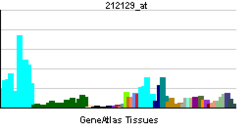- NIPA2
-
Non imprinted in Prader-Willi/Angelman syndrome 2 Identifiers Symbols NIPA2; MGC5466 External IDs OMIM: 608146 MGI: 1913918 HomoloGene: 11368 GeneCards: NIPA2 Gene Gene Ontology Molecular function • protein binding Cellular component • early endosome
• plasma membrane
• integral to membraneBiological process • ion transport
• magnesium ion transportSources: Amigo / QuickGO RNA expression pattern 

More reference expression data Orthologs Species Human Mouse Entrez 81614 93790 Ensembl ENSG00000140157 ENSMUSG00000030452 UniProt Q8N8Q9 Q921M1 RefSeq (mRNA) NM_001008860.2 NM_023647.5 RefSeq (protein) NP_001008860.1 NP_076136.2 Location (UCSC) Chr 15:
23 – 23.03 MbChr 7:
63.19 – 63.22 MbPubMed search [1] [2] Non-imprinted in Prader-Willi/Angelman syndrome region protein 2 is a protein that in humans is encoded by the NIPA2 gene.[1][2]
References
- ^ Chai JH, Locke DP, Greally JM, Knoll JH, Ohta T, Dunai J, Yavor A, Eichler EE, Nicholls RD (Sep 2003). "Identification of four highly conserved genes between breakpoint hotspots BP1 and BP2 of the Prader-Willi/Angelman syndromes deletion region that have undergone evolutionary transposition mediated by flanking duplicons". Am J Hum Genet 73 (4): 898–925. doi:10.1086/378816. PMC 1180611. PMID 14508708. http://www.pubmedcentral.nih.gov/articlerender.fcgi?tool=pmcentrez&artid=1180611.
- ^ "Entrez Gene: NIPA2 non imprinted in Prader-Willi/Angelman syndrome 2". http://www.ncbi.nlm.nih.gov/sites/entrez?Db=gene&Cmd=ShowDetailView&TermToSearch=81614.
Further reading
- Bittel DC, Kibiryeva N, Butler MG (2006). "Expression of 4 genes between chromosome 15 breakpoints 1 and 2 and behavioral outcomes in Prader-Willi syndrome". Pediatrics 118 (4): e1276–e1283. doi:10.1542/peds.2006-0424. PMID 16982806.
- Gerhard DS, Wagner L, Feingold EA et al. (2004). "The status, quality, and expansion of the NIH full-length cDNA project: the Mammalian Gene Collection (MGC)". Genome Res. 14 (10B): 2121–2127. doi:10.1101/gr.2596504. PMC 528928. PMID 15489334. http://www.pubmedcentral.nih.gov/articlerender.fcgi?tool=pmcentrez&artid=528928.
- Lefèvre C, Bouadjar B, Karaduman A et al. (2005). "Mutations in ichthyin a new gene on chromosome 5q33 in a new form of autosomal recessive congenital ichthyosis". Hum. Mol. Genet. 13 (20): 2473–2482. doi:10.1093/hmg/ddh263. PMID 15317751.
- Glinsky GV, Glinskii AB, Stephenson AJ et al. (2004). "Gene expression profiling predicts clinical outcome of prostate cancer". J. Clin. Invest. 113 (6): 913–923. doi:10.1172/JCI20032. PMC 362118. PMID 15067324. http://www.pubmedcentral.nih.gov/articlerender.fcgi?tool=pmcentrez&artid=362118.
- Ota T, Suzuki Y, Nishikawa T et al. (2004). "Complete sequencing and characterization of 21,243 full-length human cDNAs". Nat. Genet. 36 (1): 40–45. doi:10.1038/ng1285. PMID 14702039.
- Strausberg RL, Feingold EA, Grouse LH et al. (2003). "Generation and initial analysis of more than 15,000 full-length human and mouse cDNA sequences". Proc. Natl. Acad. Sci. U.S.A. 99 (26): 16899–16903. doi:10.1073/pnas.242603899. PMC 139241. PMID 12477932. http://www.pubmedcentral.nih.gov/articlerender.fcgi?tool=pmcentrez&artid=139241.
- Andersson B, Wentland MA, Ricafrente JY et al. (1996). "A "double adaptor" method for improved shotgun library construction". Anal. Biochem. 236 (1): 107–113. doi:10.1006/abio.1996.0138. PMID 8619474.
Categories:- Human proteins
- Chromosome 15 gene stubs
Wikimedia Foundation. 2010.
